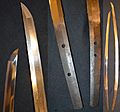Tachi facts for kids
The tachi is a special Japanese sword with a curved blade. It is longer than another famous Japanese sword called the katana. The tachi was used in battles a long time ago, even before the katana became popular. This means it's an older type of sword. The word "Tachi" means "the soul of bushi," which refers to the soul of a samurai warrior.
When the katana started being used more often, the tachi became a sword mostly for ceremonies and special events. These ceremonial tachi swords often looked very fancy. They had traditional cord wrappings and handles with special designs.
Contents
What Makes a Tachi Special?
A tachi blade was usually about 30.7 inches (around 75 centimeters) long. Because of its length, the tachi was a great sword for cavalry warriors, especially those riding horses. Its strong curve made it easy to make slicing attacks. Even though it was long, the tachi was light enough to be used with just one hand. It also had a long enough handle, called a hilt, so warriors could hold it with two hands if they needed to. This was helpful for warriors who were fighting on foot.
How Was the Tachi Worn?
The tachi was worn hanging from the belt with its sharp edge pointing downwards. This is different from the katana, which was worn with its sharp edge pointing upwards. Not all tachi swords were the same size. Smaller ones were called ko-dachi, and swords longer than the usual size were known as o-dachi.
How Samurai Used Their Tachi Swords
If you see a tachi in a museum today, you might notice small chips along the back (blunt side) of the sword. However, the sharp cutting edge often looks perfect and shiny. Experts believe that samurai warriors used their tachi swords very carefully to defeat enemies. When two swords were about to hit each other, samurai would turn their swords so that only the blunt back of the blades would collide. The super sharp cutting edge was saved for the final attacks, like cutting the enemy's body.
Related pages
Images for kids
-
A katana modified from a tachi forged by Masamune. Sōshū school. 14th century, Kamakura period. Important Cultural Property. Tokyo National Museum. As it was owned by Ishida Mitsunari, it was commonly called Ishida Masamune.
-
Daishō style handachi sword mounting. 16th-17th century, Azuchi–Momoyama or Edo period.
-
Nikkō Sukezane, by Sukezane. Bizen Fukuoka-Ichimonji school. This sword was owned by Tokugawa Ieyasu.
-
Koryū Kagemitsu, by Kagemitsu. Bizen Osafune school. This sword was owned by Kusunoki Masashige.
-
Mikazuki Munechika, by Sanjō Munechika. A Yamashiro Sanjō school. Late 10th century, Heian period. National Treasure. Tokyo National Museum. This sword is one of the "Five Swords under Heaven". (天下五剣 Tenka Goken)
-
Dojikiri, by Yasutsuna. Ko-Hōki (old Hōki) school. 12th century, Heian period, National Treasure, Tokyo National Museum. This sword is one of the "Five Swords Under Heaven". (天下五剣 Tenka Goken)
-
A tachi forged by Rai Kunitoshi. Late Kamakura period. (top) Katana style mounting, Early Meiji period. (bottom)
-
A tachi forged by Osafune Kanemitsu. Nanboku-chō period. (top) Tachi mounting, Late Edo period. (bottom)
See also
 In Spanish: Tachi para niños
In Spanish: Tachi para niños

















